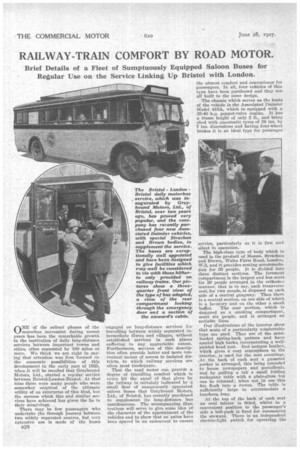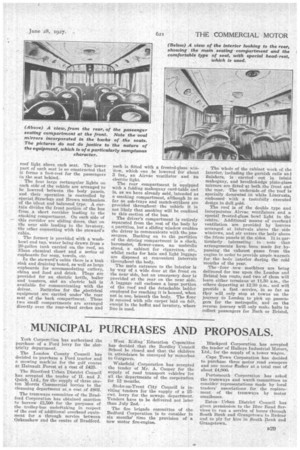RAILWAY-TRAIN COMFORT BY ROAD MOTOR.
Page 46

Page 47

If you've noticed an error in this article please click here to report it so we can fix it.
Brief Details of Regular Use a Fleet of Sumptuously Equipped Saloon Buses for on the Service Linking Up Bristol with London.
ONE of the salient phases of the motorbus movera6nt during recent years has been the remarkable growth in the institution of daily long-distance services between important towns and cities, often separated by 100 miles or more. We think we are right in saying that attention was first focused on the economic possibilities of this development in the early part of 1925, when it will be recalled that Greyhound Motors, Ltd., started a regular service between Bristol-London-Bristol. At that time there were many people who were somewhat sceptical of the ultimate utility of an enterprise of this kind, but the success which this and similar services have achieved has given the lie to their misgivings.
There may be few passengers who undertake the through journey between two widely separated centres, but very extensive use is made of the buses
engaged on long-distance services for travelling between widely separated intermediate tOwns and villages, without established services in such places suffering to any appreciable extent. Furthermore, services of this description often provide better and more convenient means of access to isolated districts, to which railway services are often most inadequate.
That the road motor can provide a degree of travelling comfort which is every bit the equal of that given by the railway is certainly indicated by a small fleet of sumptuously appointed saloon buses that Greyhound Motors, Ltd., of Bristol, has recently purchased to supplement its long-distance bus ramifications. The accompanying illustrations will serve to give some idea of the character of the appointment of the vehicles and to show that no pains have beau. spared in an endeavour to ensure the utmost comfort and convenience for passengers. In all, four vehicles of this type have been purchased and they are all built to the same design.
The chassis which serves as the basis of the vehicle is the Associated Daimler Model 416A, which is equipped with a 35-40 h.p. poppet-valve engine. It has a frame height of only 2 ft., and being shod with pneumatic tyres of 38 ins. by 7 ins, dimensions and having four-wheel brakes it is an ideal type for passenger
service, particularly as it is fast and silent in operation.
The high-class type of body which is used is the product of Messrs. Strachan and Brown, Wales Farm Road, London, W.S, and it provides seating accommodation for 26 people. It is divided into three distinct sections. The foremost compartment is the largest and has seats for 20 people arranged in the orthodoy: manner, that is to say, each transverse seat, for two people, is disposed on each side of a central gangway. Then there is a central section, on one side of which is a lavatory and on the other a small buffet. The rear portion, which is designed as a smoking compartment, seats six people, and is arranged on sociable lines.
Our illustrations of the interior show that seats of a particularly comfortable type are used. They are of the semibucket spring-back pattern and have special high baek.s, incorporating a wellpadded head rest. Red antique leather, which gives a cosy atmosphere to the interior, is used for the seat coverings. ,At the back of each seat a gusseted pocket is arranged, this being intended to house newspapers and periodicals, and by pulling a tab a small folding mahogany table with a plate-glass top can be released ; when not in use this fits flush into a recess. The table is sufficiently large to accommodate a luncheon tray.
At the top of the back of each seat an oval mirror is fitted, whilst in a convenient position to the passenger's side a bell-push is fixed for summoning the steward. There is an independent electric-light switch for operating the roof light above each seat. The lower Part of each seat is so constructed that it forms a font-rest for the passengers :irt the seat behind.
The four large rectangular lights on each side of the vehicle are arranged to be lowered between the body panels, and their operation is controlled by opecial Strachan and Brown mechanism of the silent and balanced type. A curtain divides the front portion or the bus from a short corridor leading to the smoking compartment. On each side of this corridor are sliding doors, that on the near side leading to the lavatory, the other connecting with the steward's cabin.
The formen is provided With a washbowl and tap, water being drawn from a 20-gallon tank carried om the roof, au.
• Elsan chemical closet and a series of cupboards for soap, towels, etc.
In the steward's cabin there is a teak sink and draining board, as well as large cupboards for accommodating cutlery, china and food and drink. Plugs are provided for an electric kettle, boiler and toasters, and an electric bell is available for communicating with the driver. Batteries for the electrical equipment are carried. under the rear seat of the back compartment. These two small compartments are arranged directly over the rear-wheel arches and
each is fitted with a frosted-glass win'Clow, which can be lowered for about 3 ins., an Aimic ventilator and an electric light.
The rear compartment is equipped with a folding mahogany card-table and is, as we have already said, intended as a smoking compartment, although in so far as ash-trays and match-strikers are provided throughout the vehicle it is not likely that smoking will be confined to this section of the bus.
The driver's compartment is entirely separated from the rest of the body by a partition, but a sliding window enables the driver to communicate with the passengers. Backing on to the partition of the driving compartment is a clock, barometer, flower-vases, an umbrella stand, a cabinet. for cigarettes, etc., whilst racks for hats and light luggage are disposed at convenient intervals throughout the body.
The main entrance to the interior is by way of a wide door at the front on the near side, but an emergency door is provided at the rear on the near side. A luggage rail encloses a large portion of the roof and the detachable ladder employed for reaching it is housed, when not in use, beneath the body. The floor N covered with pile carpet laid on felt, except in the buffet and lavatory, where lino is used. The-whole of the cabinet work of the interior,-including the garnish rails and finishers, is carried out in inlaid mahogany, and bevelled-edge plate-glass mirrors are fitted at both. the front and the rear. The underside .of the roof is specially decorated in white Lincrusta, embossed with a tastefully executed
design in dull gold. . •
The roof is of the double type and incorporates Airvae ventilators and a special frosted-glass bowl light in the centre. Additional means. of overhead ventilation are. provided by lotivres arranged at intervals, above the side windows, and air enters the body above the frieze panels at the sides. It is particularly • interesting-to . note that arrangements. have, been made for bypassing. the exhaust gases from the engine in order to provide ainple.warmth for the .body interior during the cold months of the year.
The -four new machines are being delivered for -use upon the Loudon and Bristol bus 'route, and two of them will leave either terminus at 11.30 a.m., the others departing at 12.30 p.m., and will provide a fast service, in so far as they wild only stop at towns on the journey to London to pick up passengers for the metropolis, and on the reverse journey will only maim halts to collect passengers for Bath or Bristol.




































































































